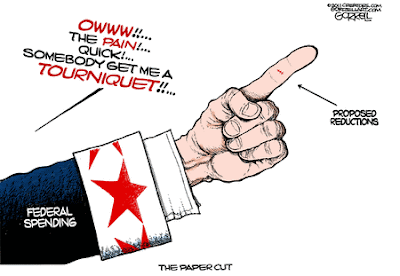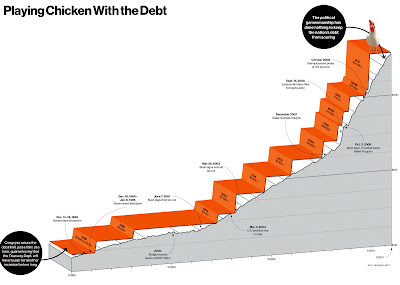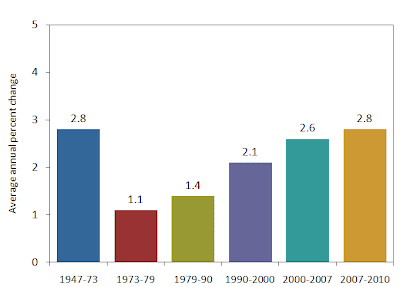
Economics, as a branch of the more general theory of human action, deals with all human action, i.e., with mans purposive aiming at the attainment of ends chosen, whatever these ends may be.--Ludwig von Mises
Friday, April 29, 2011
2011 1st Quarter GDP: 1.8%
Thursday, April 28, 2011
Wednesday, April 27, 2011
Bourgeois Revaluation
Economist and historian Deirdre McCloskey calls it "the Great Fact" -- the humongous increase in humans' standard of living that began about 200 years ago.
And what a Great Fact it is! It's great not only in the sense of being amazingly, resplendently good for ordinary men and women, but also in the sense of being the single most surprising and astounding change that we humans have experienced in our 70,000 or so years on this planet...
Then all of a sudden, starting a mere 200 or so years ago in northwestern Europe, boom!
Material riches start pouring forth not only into the castles and manor houses of royalty and the nobility, but into the humble homes of peasants, of hoi polloi, of human creatures who, generation after generation -- tracing back all the way to their single-celled ancestors -- lived lives poor, nasty, brutish and short.
What did our great-great-great-great-grandparents do to suddenly deserve access to new and remarkable goods such as underwear made of tightly woven cloth that could be vigorously washed without unraveling?...
Only when merchants, tinkerers and practical seekers of profit in markets came to be respected -- and to be widely spoken of with respect, even with admiration -- did the social status of the bourgeoisie increase enough to make membership in that group desirable to large numbers of people. And when this Bourgeois Revaluation happened, innovation skyrocketed.
It's this innovation -- mad, fevered, historically off-the-charts amounts of innovation -- that really is what we today call "capitalism."
Tuesday, April 26, 2011
State Income Tax Rates
Monday, April 25, 2011
Sunday, April 24, 2011
Saturday, April 23, 2011
Doug Casey on Gold
Historically – actually just up until the decades after World War I, when world governments started issuing paper currency with no relation to gold – the metal was cash, and it was used as money everywhere, on a daily basis. I believe that will again be the case in the fairly near future.The question is: At what price will that occur, relative to other things? It’s not just a question of picking a dollar price, because the relative value of many things – houses, food, commodities, labor – have been distorted by a very long period of currency inflation, increased taxation and very burdensome regulation that started at the beginning of the last depression. Especially with the fantastic leaps in technology now being made and breathtaking advances that will soon occur, it’s hard to be sure exactly how values will realign after the Greater Depression ends. And we can’t know the exact manner in which it will end. Especially when you factor in the rise of China and India.
A guess? I’ll say the equivalent of about $5,000 an ounce of today’s dollars. And I feel pretty good about that number, considering where we are in the current gold bull market. Classic bull markets have three stages. We’ve long since left the “Stealth” stage – when few people even remembered gold existed, and those who did mocked the idea of owning it. We’re about to leave the “Wall of Worry” stage, when people notice it and the bulls and bears battle back and forth. I’ll conjecture that within the next year we’ll enter the “Mania” stage – when everybody, including governments, is buying gold, out of greed and fear. But also out of prudence.
The policies of Bernanke and Obama – but also of almost every other central bank and government in the world – are not just wrong. These people are, perversely, doing just the opposite of what should be done to cure the problems that have built up over decades. One consequence of their actions will be to ignite numerous other bubbles in various markets and countries. I expect the biggest bubble will be in gold, and the wildest one in mining and exploration stocks.
When will I sell out of gold and gold stocks? Of course, they don’t ring a bell at either the top or the bottom of the market. But I expect to be a seller when there really is a bubble, a mania, in all things gold-related. There’s a good chance that will coincide to some degree with a real bottom in conventional stocks. I don’t know what level that might be on the DJIA, but I’d think its average dividend yield might then be in the 6 to 8% area.
The bottom line is that gold and its friends are no longer cheap, but they have a long way – in both time and price – to run. Until they're done, I suggest you be right and sit tight.
read the entire essay
Friday, April 22, 2011
Cartoon: New Technology
Thursday, April 21, 2011
Cartoon: The Falling Dollar
So why is gasoline so expensive, when oil is so far off its record price?

Those prices are for a particular type of oil -- West Texas Intermediate -- that's stored in Cushing, Okla.
Thanks to increasing supplies from the Rocky Mountain states and Canada's oil sands, plus a lack of pipelines to move that oil out, there's currently a big glut of oil in Cushing. That's pushing the price of West Texas crude down.
Prices for most other types of oil, which make up the vast majority of oil that refiners use in U.S. gasoline, are much higher than West Texas Intermediate. London's Brent crude, for example, was closer to $124 a barrel on Wednesday.
Cartoon: Tech-Nerds
Wednesday, April 20, 2011
Tuesday, April 19, 2011
Cartoon: S and P
Historic Tax Rates

Monday, April 18, 2011
Taxing the Rich
Friday, April 15, 2011
Big Government
Government Shutdown
Happy Tax Day
CPI: 2.7%

Thursday, April 14, 2011
Wednesday, April 13, 2011
What Cuts?
 Republican and Democrat leaders have agreed to cut federal funding by $38 billion this year (versus fiscal 2010). What does that mean for the overall spending picture? Based on estimates from the Congressional Budget Office, total federal outlays will still rise by approximately $177 billion.
Republican and Democrat leaders have agreed to cut federal funding by $38 billion this year (versus fiscal 2010). What does that mean for the overall spending picture? Based on estimates from the Congressional Budget Office, total federal outlays will still rise by approximately $177 billion. Budget Antics



Tuesday, April 12, 2011
New CPI Index
 The “F” in CPI-F stands for “flat” and this index is calculated by taking the overall consumer price index and excluding more items from it, much in the same way that food and energy have been excluded from “core” inflation, the preferred measure amongst Fed economists. For CPI-F, those items that are increasing in price at a rate of more than 1.5 percent would be excluded … along with those items that are increasing in price at a rate of less than 1.5 percent and items whose prices are falling. The index currently stands at 1.5 percent. source
The “F” in CPI-F stands for “flat” and this index is calculated by taking the overall consumer price index and excluding more items from it, much in the same way that food and energy have been excluded from “core” inflation, the preferred measure amongst Fed economists. For CPI-F, those items that are increasing in price at a rate of more than 1.5 percent would be excluded … along with those items that are increasing in price at a rate of less than 1.5 percent and items whose prices are falling. The index currently stands at 1.5 percent. source
International Trade Feb. 2011


Monday, April 11, 2011
Two Budgets
 Somehow, we could ratchet up spending by hundreds of billions at the drop of a hat. Reducing spending by less than $100 billion becomes Armageddon. Arnold Kling source
Somehow, we could ratchet up spending by hundreds of billions at the drop of a hat. Reducing spending by less than $100 billion becomes Armageddon. Arnold Kling source Sunday, April 10, 2011
How to Eliminate Social Security and Medicare
How to Eliminate Social Security and Medicare Expenditures under the Social Security and Medicare programs account for approximately one-third of total federal government spending. It is obvious that any major reduction in government spending requires major reductions in spending for these programs. Unfortunately, Social Security and Medicare are generally regarded as sacred and thus virtually untouchable, with the result that few if any proposals have been made that would greatly reduce the spending they entail... This program will undoubtedly seem much too slow for some supporters of individual rights and freedom. Nevertheless, I believe that it is in fact the most rapid means of achieving its ultimate goal that does not entail a revolutionary overthrow of what have come to be established rights in the law, however wrongheaded the law has been in establishing those rights in the first place. Proceeding in this way is an essential aspect of liberalism in its classical sense. Fundamentally, rights to entitlements of any kind, that must be paid for involuntarily by other people, are no more legitimate than the alleged property rights of slave owners in their slaves. Yet to avoid civil war, liberalism would have urged a policy of compensated emancipation rather than one of violent emancipation. Today, in fundamentally similar circumstances, liberalism must limit as far as possible the disturbance that would otherwise be caused by the elimination of illegitimate, perverted rights... If we want to protect the value of individual human life, particularly in old age, when it is most vulnerable, we must reverse direction and start dismantling Social Security and Medicare, two potentially deadly collectivist institutions. We must restore to the individual the responsibility and the power to determine his own future through forethought and saving. The individual must have his own individual property with the freedom to use it for his own well-being, as he sees fit. Government officials must be barred from the process. source
Friday, April 8, 2011
Thursday, April 7, 2011
Wednesday, April 6, 2011
NASDAQ 100: Rebalancing

Nasdaq OMX is rebalancing the Nasdaq-100 index (QQQs), which currently has one company — Apple (AAPL) as more than 20% of the index.
The WSJ notes “Apple’s market capitalization is roughly $300 billion, twice that of Google. But its weighting in the index was five times that of Google. After the rebalancing, Google’s share of the index will be 5.8% compared to Apple’s 12.3%. Apple will remain the largest component of the index.”
 source
source
 source
source
 source
source
















 source
source 

 source
source 











